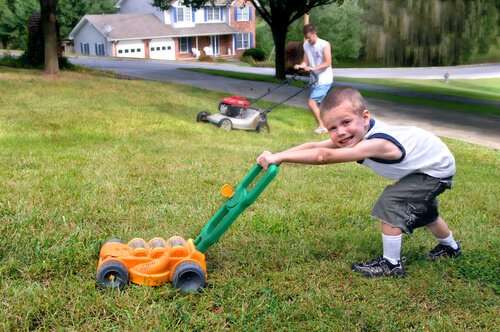How Children Learn By Imitation

Children learn by imitation, as this is the first and oldest learning model for all species. Both animals and humans learn the most basic behaviors this way.
This includes everything from how to feed themselves to the way they communicate, actions that they incorporate just by imitating and reproducing everything their parents (or the individuals who live with them) do.
However, it’s so fundamental for children to learn by imitation that they can also reproduce bad behaviors and habits that will accompany them throughout their lives.
Therefore, it’s essential for parents to be aware of the fact that children constantly learn by imitation. Adults must always be alert about what they do around children.
How children learn by imitation
Always keep in mind that learning by imitation is driven by the innate curiosity of children. Many of the behaviors they copy don’t arise from conscious decisions.
Now, there is an extensive universe of attributes related to the human habits and behaviors that children learn and reproduce. The most important are those linked to speech, habits, emotional responses and social behaviors.
Learning by imitation linked to speech
Children undoubtedly learn to communicate from imitation. Speech therapists say that children not only reproduce the parents’ way of speaking, but also their tone of voice.
As we noted earlier, parents should pay special attention to the way they communicate with children.

There are many recorded cases in which children may or may not start speaking at a certain age as the result of either a lack of communication from parents or by overindulging and constantly speaking to them as babies.
However, children learn by imitation to speak not only in their initial years of development, but all the way into adulthood.
Children can learn to speak quickly, slowly, with a high or low tone of voice, with a strong accent or with bad words as a consequence of what they hear at home and at school.
Learning by imitation linked to habits
The second type of learning that children often copy is related to habits. Combing their hair, eating at certain times of the day, bathing, being punctual, exercising, being bossy and collaborating are qualities that children learn in a very simple way. Obviously, it occurs just by imitating the actions of their parents at home.
Therefor, it’s not enough to simply ask children to be well-mannered. Parents must also watch their behavior at home on a daily basis.
“It’s essential for parents to be aware that learning by imitation happens constantly.”
Learning emotional responses and social behaviors
In many cases, violent or depressed children simply recreate the environment they live in at home. Many children, for example, suffer from anxiety resulting from an emotional response created from their parents’ nervous and constantly alert behaviors. Thus, they convey to the child a constant sense of danger.
To cite a concrete example: we can often notice that the treatment girls receive from their parents is the same treatment they give to their dolls when they imitate the authority figures of the house.

On the one hand, some girls take their dolls and shout at and punish them. Others clap their hands. Some also speak to their dolls in a loving and overprotective way.
In reviewing the mothers’ behaviors, it is evident that the children learned a social behavior and linked it to emotional responses based exclusively on imitation.
If, as parents, you set goals about what you want your children to learn, it’s essential that you get rid of negative behaviors as much as possible. Consider what actions can serve as a bad example for children, and try to avoid them.
Remember that, almost like sponges, they will assimilate all the behaviors of the home and its environment.
Children learn by imitation, as this is the first and oldest learning model for all species. Both animals and humans learn the most basic behaviors this way.
This includes everything from how to feed themselves to the way they communicate, actions that they incorporate just by imitating and reproducing everything their parents (or the individuals who live with them) do.
However, it’s so fundamental for children to learn by imitation that they can also reproduce bad behaviors and habits that will accompany them throughout their lives.
Therefore, it’s essential for parents to be aware of the fact that children constantly learn by imitation. Adults must always be alert about what they do around children.
How children learn by imitation
Always keep in mind that learning by imitation is driven by the innate curiosity of children. Many of the behaviors they copy don’t arise from conscious decisions.
Now, there is an extensive universe of attributes related to the human habits and behaviors that children learn and reproduce. The most important are those linked to speech, habits, emotional responses and social behaviors.
Learning by imitation linked to speech
Children undoubtedly learn to communicate from imitation. Speech therapists say that children not only reproduce the parents’ way of speaking, but also their tone of voice.
As we noted earlier, parents should pay special attention to the way they communicate with children.

There are many recorded cases in which children may or may not start speaking at a certain age as the result of either a lack of communication from parents or by overindulging and constantly speaking to them as babies.
However, children learn by imitation to speak not only in their initial years of development, but all the way into adulthood.
Children can learn to speak quickly, slowly, with a high or low tone of voice, with a strong accent or with bad words as a consequence of what they hear at home and at school.
Learning by imitation linked to habits
The second type of learning that children often copy is related to habits. Combing their hair, eating at certain times of the day, bathing, being punctual, exercising, being bossy and collaborating are qualities that children learn in a very simple way. Obviously, it occurs just by imitating the actions of their parents at home.
Therefor, it’s not enough to simply ask children to be well-mannered. Parents must also watch their behavior at home on a daily basis.
“It’s essential for parents to be aware that learning by imitation happens constantly.”
Learning emotional responses and social behaviors
In many cases, violent or depressed children simply recreate the environment they live in at home. Many children, for example, suffer from anxiety resulting from an emotional response created from their parents’ nervous and constantly alert behaviors. Thus, they convey to the child a constant sense of danger.
To cite a concrete example: we can often notice that the treatment girls receive from their parents is the same treatment they give to their dolls when they imitate the authority figures of the house.

On the one hand, some girls take their dolls and shout at and punish them. Others clap their hands. Some also speak to their dolls in a loving and overprotective way.
In reviewing the mothers’ behaviors, it is evident that the children learned a social behavior and linked it to emotional responses based exclusively on imitation.
If, as parents, you set goals about what you want your children to learn, it’s essential that you get rid of negative behaviors as much as possible. Consider what actions can serve as a bad example for children, and try to avoid them.
Remember that, almost like sponges, they will assimilate all the behaviors of the home and its environment.
All cited sources were thoroughly reviewed by our team to ensure their quality, reliability, currency, and validity. The bibliography of this article was considered reliable and of academic or scientific accuracy.
- Bandura, A. (1978). Aprendizaje vicario. México, Trillas.
- Ahmed, Y. M. R., & Yasmina, M. (2010). Aprendizaje vicario: implicaciones educativas en el aula. Revista digital para profesionales de la enseñanza, 10, 1-6.
- Zurita Rovalino, M. E. (2018). El aprendizaje por imitación y la identificación de roles en los niños y niñas de la Unidad Educativa Madre Gertrudis del cantón Cevallos provincia del Tungurahua (Bachelor’s thesis, Universidad Tècnica de Ambato. Facultad de Ciencias Humanas y de la Educaciòn. Carrera de Educaciòn Parvularia). https://repositorio.uta.edu.ec/handle/123456789/28650
This text is provided for informational purposes only and does not replace consultation with a professional. If in doubt, consult your specialist.








